Grand Duchess Anastasia Nikolaevna Of Russia
 From Nwe
From Nwe
| Anastasia Nikolaevna | |
|---|---|
| Grand Duchess Anastasia of Russia | |
 |
|
| Grand Duchess Anastasia knitting in her mother's boudoir. | |
| Father | Nicholas II of Russia |
| Mother | Alexandra Fyodorovna of Hesse |
| Born | June 18 1901 Peterhof, Saint Petersburg, Empire of All the Russias |
| Died | July 17 1918 (17 years, 29 days) Russian Soviet Federative Socialist Republic, Union of Soviet Socialist Republics |
| Burial | Peter and Paul Cathedral, Saint Petersburg, Russian Federation |
Grand Duchess Anastasia of Russia (Anastasia Nikolaevna Romanova), (Russian: Великая Княжна Анастасия Николаевна Романова) (June 18 [O.S. June 5] 1901 – July 17, 1918), was the youngest daughter of Tsar Nicholas II of Russia, the last sovereign of Imperial Russia, and his wife Alexandra Fyodorovna.
Anastasia was a younger sister of Grand Duchess Olga, Grand Duchess Tatiana and Grand Duchess Maria, and was an elder sister of Alexei Nikolaievitch, Tsarevitch of Russia. She was murdered with her family on July 17, 1918, during the Russian Civil War by forces of the Bolshevik secret police. The Bolsheviks wished to prevent any possibility that the royal family might fall into the hands of the White Army that was loyal to the old regime, thus undercutting the tenuous legitimacy of the Soviet government, which had seized control of the country in a coup d'etat against Alexander Kerensky's Provisional Government.
Persistent rumors of her possible escape circulated since her death, fueled by the fact that the location of her burial was unknown during the decades of Communist rule. The mass grave near Ekaterinburg which held the remains of the Tsar, his wife, and three daughters was only revealed in 1991, but the bodies of Alexei Nikolaevich and one of his sisters—either Anastasia or her elder sister Maria—were not discovered there.
Her possible survival has been totally disproven, but for many years it was considered a fact by many people with affiliation or sympathy toward the Romanov family.
Biography
Life and childhood
When Anastasia was born, her parents and extended family were disappointed to have a fourth daughter. Tsar Nicholas II went for a long walk to compose himself before going to visit Tsarina Alexandra and the newborn Anastasia for the first time.[1] One meaning of her name is "the breaker of chains" or "the prison opener." The fourth grand duchess received her name because, in honor of her birth, her father pardoned and reinstated students who had been imprisoned for participating in riots in Saint Petersburg and Moscow the previous winter. Another meaning of the name is "of the resurrection," a fact often alluded to later in stories about her rumored survival. Anastasia's title is most precisely translated as "Grand Princess," meaning that Anastasia, as an "Imperial Highness" was higher in rank than other Princesses in Europe who were "Royal Highnesses." "Grand Duchess" became the most widely used translation of the title into English from Russian.[2]
The Tsar's children were raised as simply as possible. They slept on hard camp cots without pillows, except when they were ill; they took cold baths in the morning, and were expected to tidy their rooms and do needlework to be sold at various charity events when they were not otherwise occupied. Most in the household, including the servants, generally called the Grand Duchess by her first name and patronym, Anastasia Nikolaevna, and did not use her title or "Her Imperial Highness." She was occasionally called by the French version of her name, "Anastasie," or by the Russian nicknames "Nastya," "Nastas," or "Nastenka." Other family nicknames for Anastasia were "Malenkaya," meaning "little (one),"[3] or "shvibzik," the Russian word for "imp."
Living up to her nicknames, young Anastasia grew into a vivacious and energetic child, described as short and inclined to be chubby, with blue eyes[4] and reddish-[5]blond hair.[6] Margaretta Eagar, a governess to the four Grand Duchesses, said one person commented that the toddler Anastasia had the greatest personal charm of any child he had ever seen.[7]
While often described as gifted and bright, she was never interested in the restrictions of the school room, according to her tutors Pierre Gilliard and Sydney Gibbes. Gibbes, Gilliard, and ladies-in-waiting Lili Dehn and Anna Vyrubova described Anastasia as lively, mischievous, and a gifted actress. Her sharp, witty remarks sometimes hit sensitive spots.[8][9][6]
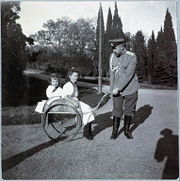
Anastasia's daring occasionally exceeded the limits of acceptable behavior. "She undoubtedly held the record for punishable deeds in her family, for in naughtiness she was a true genius," said Gleb Botkin, son of the court physician Yevgeny Botkin, who later died with the family at Ekaterinburg.[10] Anastasia sometimes tripped the servants and played pranks on her tutors. As a child, she would climb trees and refuse to come down. Once, during a snowball fight at the family's Polish estate, Anastasia rolled a rock into a snowball and threw it at her older sister Tatiana, knocking her to the ground.[6] A distant cousin, Princess Nina Georgievna, recalled that "Anastasia was nasty to the point of being evil," and would cheat, kick and scratch her playmates during games; she was affronted because the younger Nina was taller than she was.[11] She was also less concerned about her appearance than her sisters. Hallie Erminie Rives, a best-selling American author and wife of an American diplomat, described how ten-year-old Anastasia ate chocolates without bothering to remove her long, white opera gloves at the Saint Petersburg opera house.[12]
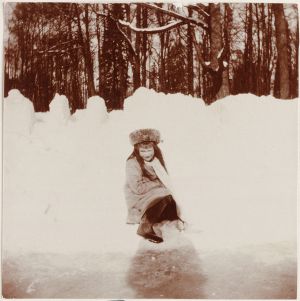
Anastasia and her older sister Maria were known within the family as "The Little Pair." The two girls shared a room, often wore variations of the same dress, and spent much of their time together. Their older sisters, Olga and Tatiana, also shared a room and were known as "The Big Pair." The four girls sometimes signed letters using the nick name, OTMA, which was derived from the first letters of their first names.[13]
Despite her energy, Anastasia's physical health was sometimes poor. The Grand Duchess suffered from the painful condition hallux valgus (bunions), which affected both of her big toes.[14] Anastasia had a weak muscle in her back and was prescribed twice-weekly massage. She hid under the bed or in a cupboard to put off the massage.[15] Anastasia's older sister, Maria, reportedly hemorrhaged in December 1914 during an operation to remove her tonsils, according to her paternal aunt Grand Duchess Olga Alexandrovna of Russia, who was interviewed later in her life. The doctor performing the operation was so unnerved that he had to be ordered to continue by Maria's mother, Tsarina Alexandra. Olga Alexandrovna said she believed all four of her nieces bled more than was normal and believed they were carriers of the hemophilia gene, like their mother.[16] Symptomatic carriers of the gene, while not hemophiliacs themselves, can have symptoms of hemophilia including a lower than normal blood clotting factor that can lead to heavy bleeding.[17] Anastasia, like all her family, doted on the long-awaited heir, Tsarevich Alexei, or "Baby," who suffered frequent attacks of hemophilia and nearly died several times.
Association with Grigori Rasputin
Her mother relied on the counsel of Grigori Rasputin, a Russian peasant and wandering старец (starets or "holy man"), and credited his prayers with saving the ailing Tsarevich on numerous occasions. Anastasia and her siblings were taught to view Rasputin as "Our Friend" and to share confidences with him. In the autumn of 1907, Anastasia's aunt Grand Duchess Olga Alexandrovna of Russia was escorted to the nursery by the Tsar to meet Rasputin. Anastasia, her sisters and brother Alexei were all wearing their long white nightgowns.
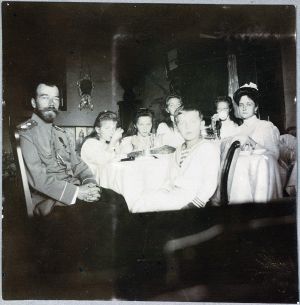
"All the children seemed to like him," Olga Alexandrovna recalled. "They were completely at ease with him."[18] Rasputin's friendship with the Imperial children was evident in some of the messages he sent to them. In February 1909, Rasputin sent the imperial children a telegram, advising them to "Love the whole of God's nature, the whole of His creation in particular this earth. The Mother of God was always occupied with flowers and needlework."[19]
However, one of the girls' governesses, Sofia Ivanovna Tyutcheva, was horrified in 1910 that Rasputin was permitted access to the nursery when the four girls were in their nightgowns and wanted him barred. Nicholas asked Rasputin to avoid going to the nurseries in the future. The children were aware of the tension and feared that their mother would be angered by Tyutcheva's actions. "I am so afr(aid) that S.I. (governess Sofia Ivanovna Tyutcheva) can speak… about our friend something bad," Anastasia's 12-year-old sister Tatiana wrote to their mother on March 8, 1910. "I hope our nurse will be nice to our friend now."[20] Alexandra eventually had Tyutcheva fired.

Tyutcheva took her story to other members of the family.[21] While Rasputin's visits to the children were, by all accounts, completely innocent in nature, the family was scandalized. Tyutcheva told Nicholas's sister, Grand Duchess Xenia Alexandrovna of Russia, that Rasputin visited the girls, talked with them while they were getting ready for bed, and hugged and patted them. Tyutcheva said the children had been taught not to discuss Rasputin with her and were careful to hide his visits from the nursery staff. Xenia wrote on March 15, 1910 that she couldn't understand "the attitude of Alix and the children to that sinister Grigory (whom they consider to be almost a saint, when in fact he's only a khlyst!)"[20] Khlysty was a derogatory corruption of the term Khristy, short for "Christ-believer," a schismatic group who separated from the Russian Orthodox Church.
In the spring of 1910, Maria Ivanovna Vishnyakova, a royal governess, claimed that Rasputin had raped her. Vishnyakova said the empress refused to believe her account of the assault, and insisted that "everything Rasputin does is holy."[22] Grand Duchess Olga Alexandrovna was told that Vishnyakova's claim had been immediately investigated, but instead "they caught the young woman in bed with a Cossack of the Imperial Guard." Vishnyakova was kept from seeing Rasputin after she made her accusation and was eventually dismissed from her post in 1913.[23]
However, rumors persisted and it was later whispered in society that Rasputin had seduced not only the Tsarina but also the four grand duchesses.[24] The gossip was fueled by ardent, yet by all accounts innocent, letters written to Rasputin by the Tsaritsa and the four grand duchesses which were released by Rasputin and which circulated throughout society.
This was followed by circulation of pornographic cartoons, which depicted Rasputin having relations with the Empress, her four daughters and Anna Vyrubova.[25] After the scandal, Tsar Nicholas ordered Rasputin to leave Saint Petersburg for a time, much to Alexandra's displeasure, and Rasputin went on a pilgrimage to Palestine.[26] Despite the rumors, the imperial family's association with Rasputin continued until his murder on December 17, 1916. "Our Friend is so contented with our girlies, says they have gone through heavy 'courses' for their age and their souls have much developed," Alexandra wrote to Nicholas on December 6, 1916.[27]
In his memoirs, A.A. Mordvinov reported that the four Grand Duchesses appeared "cold and visibly terribly upset" by Rasputin's death, and sat "huddled up closely together" on a sofa in one of their bedrooms on the night they received the news. Mordvinov recalled that the young women were in a gloomy mood and seemed to sense the political upheaval that was about to be unleashed.[28] Rasputin was buried with an icon signed on its reverse by Anastasia, her mother and her sisters. She attended his funeral on December 21, 1916, and her family planned to build a church over the site of Rasputin's grave.[29]
World War I and revolution
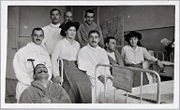
During World War I Anastasia, along with her sister Maria, visited wounded soldiers at a private hospital on the grounds at Tsarskoye Selo. The two teenagers, too young to become Red Cross nurses like their mother and elder sisters, played games of checkers and billiards with the soldiers and tried to uplift their spirits. Felix Dassel, who was treated at the hospital and knew Anastasia, recalled that the grand duchess had a "laugh like a squirrel," and walked rapidly "as though she tripped along."[30]
In February 1917, Nicholas II abdicated the throne and Anastasia and her family were placed under house arrest at the Alexander Palace in Tsarskoye Selo during the Russian Revolution. As the Bolsheviks approached, Alexander Kerensky of the Provisional Government had them moved to Tobolsk, Siberia.[31] After the Bolsheviks seized majority control of Russia, Anastasia and her family were moved to the Ipatiev House, or House of Special Purpose, at Yekaterinburg.[32]
The stress and uncertainty of captivity took their toll on Anastasia as well as her family. "Goodby," she wrote to a friend in the winter of 1917. "Don't forget us."[33] At Tobolsk, she wrote a melancholy theme for her English tutor, filled with spelling mistakes, about Evelyn Hope, a poem by Robert Browning about a young girl: "When she died she was only sixteen years old," Anastasia wrote. "Ther(e) was a man who loved her without having seen her but (k)new her very well. And she he(a)rd of him also. He never could tell her that he loved her, and now she was dead. But still he thought that when he and she will live [their] next life whenever it will be that …"[33]
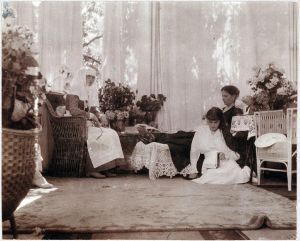
At Tobolsk, she and her sisters sewed jewels into their clothing in hopes of hiding them from their captors. She, Olga, and Tatiana were harassed by guards looking for the hidden jewels aboard the Rus', a steamship that ferried them to Yekaterinburg to join their parents and sister Maria in May 1918. Her English tutor, Sydney Gibbes, recalled hearing the grand duchesses screaming in terror and was haunted by his inability to help them.[34] Pierre Gilliard recalled his last sight of the children at Yekaterinburg: "The sailor Nagorny, who attended to Alexei Nikolaevitch, passed my window carrying the sick boy in his arms, behind him came the Grand Duchesses loaded with valises and small personal belongings. I tried to get out, but was roughly pushed back into the carriage by the sentry. I came back to the window. Tatiana Nikolayevna came last carrying her little dog and struggling to drag a heavy brown valise. It was raining and I saw her feet sink into the mud at every step. Nagorny tried to come to her assistance; he was roughly pushed back by one of the commissars …"[35] Less than two months later, on July 14, 1918, local priests at Yekaterinburg conducted a private church service for the family and reported that Anastasia and her family, contrary to custom, fell on their knees during the prayer for the dead.[36]
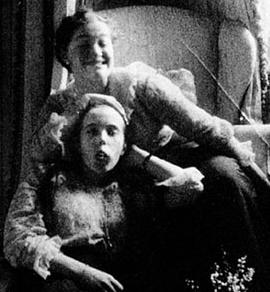
However, even in the last months of her life, she found ways to enjoy herself. She and other members of the household performed plays for the enjoyment of their parents and others in the spring of 1918. Anastasia's performance made everyone howl with laughter, according to her tutor Sydney Gibbes.[37] In a May 7, 1918 letter from Tobolsk to her sister Maria in Yekaterinburg, Anastasia described a moment of joy despite her sadness and loneliness and worry for the sick Alexei: "We played on the swing, that was when I roared with laughter, the fall was so wonderful! Indeed! I told the sisters about it so many times yesterday that they got quite fed up, but I could go on telling it masses of times …. What weather we've had! One could simply shout with joy."[38] In his memoirs, one of the guards at the Ipatiev House, Alexander Strekotin, remembered Anastasia as "very friendly and full of fun," while another guard said Anastasia was "a very charming devil! She was mischievous and, I think, rarely tired. She was lively, and was fond of performing comic mimes with the dogs, as though they were performing in a circus."[39] Yet another of the guards, however, called the youngest grand duchess "offensive and a terrorist" and complained that her occasionally provocative comments sometimes caused tension in the ranks.[40]
Anastasia was executed along with her family by a firing squad in the early morning of July 17, 1918. The extra-judicial execution was carried out by forces of the Bolshevik secret police under the command of Yakov Yurovsky.
Captivity and execution
After Tsar Nicholas II abdicated the throne in 1917, Russia quickly disintegrated into civil war. Negotiations for the release of the Romanovs between their Bolshevik (commonly referred to as 'Reds') captors and their extended family, many of whom were prominent members of the Royal Houses of Europe, stalled.[41] As the Whites (loyalists still faithful to the Tsar and the principles of autocracy) advanced toward Yekaterinburg, the Reds were in a precarious situation. The Reds knew Yekaterinburg would fall to the better manned and equipped White Army. When the Whites reached Yekaterinburg, the Imperial Family had simply disappeared. The most widely accepted account was that the family had been executed. This was due to an investigation by White Army Investigator Nicholas Sokolov, who came to the conclusion based on items that had belonged to the family being found thrown down a mine shaft at Ganina Yama.[42]
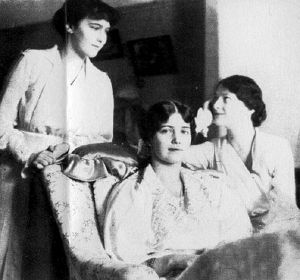
The "Yurovsky Note," an account of the event filed by Yurovsky to his Bolshevik superiors following the execution, was found in 1989 and detailed in Edvard Radzinsky's 1992 book The Last Tsar. According to the note, on the night of the murders the family was awakened and told to dress. When they asked why, they were informed that they were being moved to a new location to ensure their safety in anticipation of the violence that might ensue when the White Army reached Yekaterinburg. Once dressed, the family and the small circle of servants and caregivers that had remained with them were herded into a small room in the house's sub-basement and told to wait. Alexandra and Alexei were allowed to sit in chairs provided by guards at the request of the Tsaritsa. After several minutes, the executioners entered the room, led by Yurovsky. With no hesitation, Yurovsky quickly informed the Tsar and his family that they were all to be executed. The Tsar had time to say only "What?" and turn to his family before he was assassinated with a bullet to the head. The Tsaritsa and her daughter Olga tried to make the sign of the cross, but were killed in the initial volley of bullets fired by the executioners, both suffering gunshot wounds to the head. The rest of the Imperial retinue was shot in short order with the exception of Anna Demidova, Alexandra's maid. Demidova survived the initial onslaught but was quickly murdered against the back wall of the basement, stabbed to death while trying to defend herself with a small pillow she had carried into the sub-basement that was filled with precious gems and jewels.[43]
The "Yurovsky Note" further reported that once the thick smoke that had filled the room from so many weapons being fired in such close quarters cleared, it was discovered that the executioners' bullets had ricocheted off the corsets of two or three of the Grand Duchesses. The executioners later came to find out that this was because the family's crown jewels and diamonds had been sewn inside the linings of the corsets to hide them from their captors. The corsets thus served as a form of "armor" against the bullets. Anastasia and Maria were said to have crouched up against a wall covering their heads in terror until they were shot down by bullets, recalled Yurovsky. However, another guard, Peter Ermakov, told his wife that Anastasia had been finished off with bayonets. As the bodies were carried out, one or several of the girls cried out and were clubbed on the back of the head, wrote Yurovsky.[43]
False reports of survival and identification of Romanov remains
Anastasia's purported survival was one of the celebrated mysteries of the twentieth century. Anna Anderson, the most notorious Anastasia claimant, first surfaced publicly between 1920 and 1922. She contended that she had feigned death amongst the bodies of her family members and servants, and was able to make her escape with the help of a compassionate guard who rescued her from among the corpses after noticing that she was still alive.[44] Her legal battle for recognition from 1938 to 1970 continued a lifelong controversy and was the longest running case ever heard by the German courts where it was officially filed. The final decision of the court was that Anderson had not provided sufficient proof to claim the identity of the grand duchess.
Anderson died in 1984 and her body was cremated. DNA tests were conducted in 1994 on a tissue sample from Anderson located in a hospital and the blood of Prince Philip, Duke of Edinburgh, a grand-nephew of Empress Alexandra. According to Dr. Gill who conducted the tests, "If you accept that these samples came from Anna Anderson, then Anna Anderson could not be related to Tsar Nicholas or Tsarina Alexandra." Anderson's mitochondrial DNA was a match with a great-nephew of Franziska Schanzkowska, a missing Polish factory worker.[45] Some supporters of Anderson's claim acknowledged that the DNA tests proving she could not have been the Grand Duchess had "won the day."[46] [47]
Anna Anderson was one of at least ten women who claimed to be Anastasia. Some other lesser known claimants were Nadezhda Ivanovna Vasilyeva[48] and Eugenia Smith.[49] Two young women claiming to be Anastasia and her sister Maria were taken in by a priest in the Ural Mountains in 1919 where they lived as nuns until their deaths in 1964. They were buried under the names Anastasia and Maria Nikolaevna.[50]
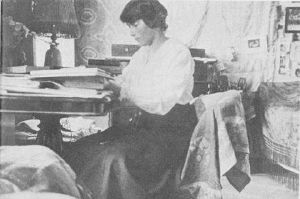
Rumors of Anastasia's survival were embellished with various contemporary reports of trains and houses being searched for 'Anastasia Romanov' by Bolshevik soldiers and secret police.[51] When she was briefly imprisoned at Perm in 1918, Princess Helena Petrovna, the wife of Anastasia's distant cousin, Prince Ioann Konstantinovich of Russia, reported that a guard brought a girl who called herself Anastasia Romanova to her cell and asked if the girl was the daughter of the Tsar. Helena Petrovna said she did not recognize the girl and the guard took her away.[52] Although other witnesses in Perm later reported that they saw Anastasia, her mother Alexandra Fyodorovna and sisters in Perm after the murder, that story is now widely discredited as nothing more than a rumor.[52]
In another incident, eight witnesses reported the recapture of a young woman after an apparent escape attempt in September 1918 at a railway station at Siding 37, northwest of Perm. These witnesses were Maxim Grigoyev, Tatiana Sitnikova and her son Fyodor Sitnikov, Ivan Kuklin and Matrina Kuklina, Vassily Ryabov, Ustinya Varankina, and Dr. Pavel Utkin, a physician who treated the girl after the incident.[53] Some of the witnesses identified the girl as Anastasia when they were shown photographs of the grand duchess by White Russian Army investigators. Utkin also told the White Russian Army investigators that the injured girl, whom he treated at Cheka headquarters in Perm, told him, "I am the daughter of the ruler, Anastasia." Utkin obtained a prescription from a pharmacy for a patient named "N" at the orders of the secret police. White Army investigators later independently located records for the prescription.[54] During the same time period in mid-1918 there were several reports of young people in Russia passing themselves off as Romanov escapees. Boris Soloviev, the husband of Rasputin's daughter Maria, defrauded prominent Russian families by asking for money for a Romanov impostor to escape to China. Soloviev also found young women willing to masquerade as one of the grand duchesses to assist in deceiving the families he had defrauded.[54]
Some biographer's accounts speculated that the opportunity for one or more of the guards to rescue a survivor existed. Yakov Yurovsky demanded that the guards come to his office and turn over items they had stolen following the murder. There was reportedly a span of time when the bodies of the victims were left largely unattended in the truck, in the basement, and in the corridor of the house. Some guards who had not participated in the murders and had been sympathetic to the grand duchesses were reportedly left in the basement with the bodies.[55]
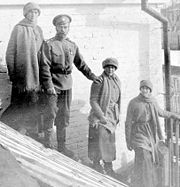
There were also reports from Bulgaria of the survival of Anastasia and her younger brother Tsarevich Alexei. In 1953, Peter Zamiatkin, who was reportedly a member of the guard of the Russian Imperial Family, told a 16-year-old fellow hospital patient that he had taken Anastasia and Alexei to his birth village near Odessa at the request of the Tsar. After the assassination of the rest of the royal family, Zamiatkin reportedly escaped with the children via ship, sailing from Odessa to Alexandria. The alleged survivors, "Anastasia" and "Alexei," reportedly lived out their lives under assumed names in the Bulgarian town of Gabarevo near Kazanlak. The Bulgarian Anastasia claimant called herself Eleonora Albertovna Kruger and died in 1954.[56]
Romanov Graves
In 1991, the presumed burial site of the Imperial Family and their servants was excavated in the woods outside Yekaterinburg. The grave had been found nearly a decade earlier, but was kept hidden by its discoverers from the Communists who still ruled the Soviet Union when the grave was originally found. The grave only held nine of the expected eleven sets of remains. DNA and skeletal analysis matched these remains to Tsar Nicholas II, Tsarina Alexandra, and three of the four Grand Duchesses (Olga, Tatiana, Maria and Anastasia). The other remains, with unrelated DNA, correspond to the family's doctor (Yevgeny Botkin), their valet (Alexei Trupp), their cook (Ivan Kharitonov) and Alexandra's maid (Anna Demidova). The late forensic expert Dr. William Maples decided that the Tsarevitch Alexei and Anastasia's bodies were missing from the family's grave. Russian scientists contested this conclusion, however, claiming that it was the body of Maria that was missing. The Russians identified Anastasia by using a computer program to compare photos of the youngest grand duchess with the skulls of the victims from the mass grave. They estimated the height and width of the skulls where pieces of bone were missing. American scientists found this method inexact.[57]
American scientists thought the missing body to be Anastasia because none of the female skeletons showed the evidence of immaturity, such as an immature collarbone, undescended wisdom teeth, or immature vertebrae in the back, that they would have expected to find in a 17-year-old. In 1998, when the remains of the Imperial Family were finally interred, a body measuring approximately 5'7" was buried under the name of Anastasia. Photographs taken of her standing beside her three sisters up until six months before the murders demonstrate that Anastasia was several inches shorter than all of them. Her mother commented on 16-year-old Anastasia's short stature in a December 15, 1917 letter, written seven months before the murders. "Anastasia, to her despair, is now very fat, as Maria was, round and fat to the waist, with short legs. I do hope she will grow."[58] Scientists considered it unlikely that the teenager could have grown so much in the last months of her life. Her actual height was approximately 5'2".[59]
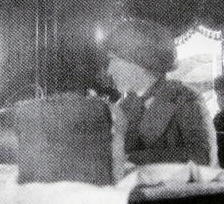
The account of the "Yurovsky Note" indicated that two of the bodies were removed from the main grave and cremated at an undisclosed area in order to further disguise the burials of the Tsar and his retinue, if the remains were discovered by the Whites, since the body count would not be correct. Searches of the area in subsequent years failed to turn up a cremation site or the remains of the two missing Romanov children.[60] However, on August 23, 2007, a Russian archaeologist announced the discovery of two burned, partial skeletons at a bonfire site near Yekaterinburg that appeared to match the site described in Yurovsky's memoirs. The archaeologists said the bones are from a boy who was roughly between the ages of ten and thirteen years at the time of his death and of a young woman who was roughly between the ages of 18 and 23 years old. Anastasia was 17 years, one month old at the time of the assassination, while her sister Maria was 19 years, one month old and her brother Alexei was two weeks shy of his fourteenth birthday. Anastasia's elder sisters Olga and Tatiana were 22 and 21 years old at the time of the assassination. Along with the remains of the two bodies, archaeologists found "shards of a container of sulfuric acid, nails, metal strips from a wooden box, and bullets of various caliber." The bones were found using metal detectors and metal rods as probes.
Preliminary testing indicated a "high degree of probability" that the remains belong to the Tsarevich Alexei and to one of his sisters, Russian forensic scientists announced on January 22, 2008. The testing began in late December 2007. On April 30, 2008, Russian forensic scientists announced that DNA testing proves that the remains belong to the Tsarevich Alexei and to one of his sisters, though several news reports are referring to Maria as the missing sister. Laboratories such as the University of Massachusetts medical school reportedly tested DNA independently from the skeletons discovered in August 2007 and have confirmed that the remains are of the Romanov children.[61]
Sainthood
In 2000, Anastasia and her family were canonized as passion bearers by the Russian Orthodox Church. The family had previously been canonized in 1981 by the Russian Orthodox Church Abroad as holy martyrs. The bodies of Tsar Nicholas II, Tsarina Alexandra, and three of their daughters were finally interred at St. Peter and Paul Cathedral in Saint Petersburg on July 17, 1998, 80 years after they were murdered.
Legacy
The purported survival of Anastasia has been the subject of both theatrical and made-for-television films. The earliest, made in 1928, was called Clothes Make the Woman. The story followed a woman who turns up to play the part of a rescued Anastasia for a Hollywood film, and ends up being recognized by the Russian soldier who originally rescued her from her would-be assassins.
The most famous is probably the highly fictionalized 1956 Anastasia starring Ingrid Bergman as Anna Anderson, Yul Brynner as General Bounine (a fictional character based on several actual men), and Helen Hayes as the Dowager Empress Marie, Anastasia's paternal grandmother. The film tells the story of a woman from an asylum who appears in Paris in 1928 and is captured by several Russian émigrés who feed her information so that they can fool Anastasia's grandmother into thinking Anderson actually is her granddaughter in order to obtain a Tsarist fortune. As time goes by they begin to suspect that this "Madame A. Anderson" really is the missing Grand Duchess.
The story served as the basis for the short-lived 1965 musical Anya.
In 1986, NBC broadcast a mini-series loosely based on a book published in 1983 by Peter Kurth called Anastasia: The Riddle of Anna Anderson. The movie, Anastasia: The Mystery of Anna was a two-part series which began with the young Anastasia Nicholaievna and her family being sent to Yekaterinburg, where they are executed by Bolshevik soldiers. The story then moves to 1923, and while taking great liberties, fictitiously follows the claims of the woman known as Anna Anderson. Amy Irving portrays the adult Anna Anderson.
The most recent film, Anastasia, 1997, an animated musical adaptation of the story of Anna Anderson's fictional escape from Russia and her subsequent quest for recognition. The film took greater liberties with historical fact than the 1956 film of the same name.
In The Romanov Prophecy, a 2004 novel by Steve Berry, the wounded Anastasia and Alexei are rescued by guards and spirited away to the United States, where they live under assumed names with a family of loyalists paid by Felix Yusupov. In the novel, both children died of illnesses in the 1920s, but not before Alexei married and fathered a son.
Ancestry
|
|
|
|
|
|
|
|
|
|
|
|
|
|
|
|
|
|
|
|
16. Nicholas I of Russia | |||||||||||||||
|
|
||||||||||||||||
|
|
|
|
|
|
||||||||||||
|
|
8. Alexander II of Russia |
|
||||||||||||||
|
|
||||||||||||||||
|
|
|
|
|
|
|
|
|
|||||||||
|
|
17. Charlotte of Prussia | |||||||||||||||
|
|
||||||||||||||||
|
|
|
|
|
|
||||||||||||
|
|
4. Alexander III of Russia |
|
||||||||||||||
|
|
||||||||||||||||
|
|
|
|
|
|
|
|
|
|
|
|
||||||
|
|
18. Louis II, Grand Duke of Hesse | |||||||||||||||
|
|
||||||||||||||||
|
|
|
|
|
|
||||||||||||
|
|
9. Marie of Hesse and by Rhine |
|
||||||||||||||
|
|
||||||||||||||||
|
|
|
|
|
|
|
|
|
|||||||||
|
|
19. Wilhelmine of Baden | |||||||||||||||
|
|
||||||||||||||||
|
|
|
|
|
|
||||||||||||
|
|
2. Nicholas II of Russia |
|
||||||||||||||
|
|
||||||||||||||||
|
|
|
|
|
|
|
|
|
|
|
|
|
|
|
|||
|
|
20. Friedrich Wilhelm, Duke of Schleswig-Holstein-Sonderburg-Glücksburg | |||||||||||||||
|
|
||||||||||||||||
|
|
|
|
|
|
||||||||||||
|
|
10. Christian IX of Denmark |
|
||||||||||||||
|
|
||||||||||||||||
|
|
|
|
|
|
|
|
|
|||||||||
|
|
21. Princess Louise Caroline of Hesse-Kassel (or Hesse-Cassel) | |||||||||||||||
|
|
||||||||||||||||
|
|
|
|
|
|
||||||||||||
|
|
5. Dagmar of Denmark |
|
||||||||||||||
|
|
||||||||||||||||
|
|
|
|
|
|
|
|
|
|
|
|
||||||
|
|
22. Prince William of Hesse | |||||||||||||||
|
|
||||||||||||||||
|
|
|
|
|
|
||||||||||||
|
|
11. Louise of Hesse-Kassel (or Hesse-Cassel) |
|
||||||||||||||
|
|
||||||||||||||||
|
|
|
|
|
|
|
|
|
|||||||||
|
|
23. Princess Louise Charlotte of Denmark | |||||||||||||||
|
|
||||||||||||||||
|
|
|
|
|
|
||||||||||||
|
|
1. Grand Duchess Anastasia Nikolaevna of Russia |
|
||||||||||||||
|
|
||||||||||||||||
|
|
|
|
|
|
|
|
|
|
|
|
|
|
|
|
|
|
|
|
24. Louis II, Grand Duke of Hesse (= 18) | |||||||||||||||
|
|
||||||||||||||||
|
|
|
|
|
|
||||||||||||
|
|
12. Prince Karl of Hesse and by Rhine |
|
||||||||||||||
|
|
||||||||||||||||
|
|
|
|
|
|
|
|
|
|||||||||
|
|
25.Wilhelmine of Baden (= 19) | |||||||||||||||
|
|
||||||||||||||||
|
|
|
|
|
|
||||||||||||
|
|
6. Louis IV, Grand Duke of Hesse |
|
||||||||||||||
|
|
||||||||||||||||
|
|
|
|
|
|
|
|
|
|
|
|
||||||
|
|
26. Prince Wilhelm of Prussia | |||||||||||||||
|
|
||||||||||||||||
|
|
|
|
|
|
||||||||||||
|
|
13. Elizabeth of Prussia |
|
||||||||||||||
|
|
||||||||||||||||
|
|
|
|
|
|
|
|
|
|||||||||
|
|
27. Marie Anna of Hesse-Homburg | |||||||||||||||
|
|
||||||||||||||||
|
|
|
|
|
|
||||||||||||
|
|
3. Alix of Hesse and by Rhine |
|
||||||||||||||
|
|
||||||||||||||||
|
|
|
|
|
|
|
|
|
|
|
|
|
|
|
|||
|
|
28. Ernest I, Duke of Saxe-Coburg and Gotha | |||||||||||||||
|
|
||||||||||||||||
|
|
|
|
|
|
||||||||||||
|
|
14. Prince Albert of Saxe-Coburg and Gotha |
|
||||||||||||||
|
|
||||||||||||||||
|
|
|
|
|
|
|
|
|
|||||||||
|
|
29. Louise of Saxe-Gotha-Altenburg | |||||||||||||||
|
|
||||||||||||||||
|
|
|
|
|
|
||||||||||||
|
|
7. Alice of the United Kingdom |
|
||||||||||||||
|
|
||||||||||||||||
|
|
|
|
|
|
|
|
|
|
|
|
||||||
|
|
30. Prince Edward Augustus, Duke of Kent and Strathearn | |||||||||||||||
|
|
||||||||||||||||
|
|
|
|
|
|
||||||||||||
|
|
15. Victoria of the United Kingdom |
|
||||||||||||||
|
|
||||||||||||||||
|
|
|
|
|
|
|
|
|
|||||||||
|
|
31. Princess Victoria of Saxe-Coburg-Saalfeld | |||||||||||||||
|
|
||||||||||||||||
|
|
|
|
|
|
||||||||||||
Notes
- ↑ Robert K. Massie, Nicholas and Alexandra (Dell Publishing Co., 1967, ISBN 0440163587), 153.
- ↑ Charlotte Zeepvat, The Camera and the Tsars: A Romanov Family Album (Sutton Publishing, 2004, ISBN 0750930497), xiv.
- ↑ Peter Kurth, Anastasia: The Riddle of Anna Anderson (Boston: Back Bay Books, 1983, ISBN 0316507172), 309.
- ↑ Massie, 1967, 134.
- ↑ Greg King and Penny Wilson, The Fate of the Romanovs (John Wiley and Sons, Inc., 2003, ISBN 0471207683), 50.
- ↑ 6.0 6.1 6.2 Anna Vyrubova, "Memories of the Russian Court". alexanderpalace.org. Retrieved August 26, 2016.
- ↑ Margaret Eagar, (1906). Six Years at the Russian Court. alexanderpalace.org. Retrieved August 26, 2016.
- ↑ Pierre Gilliard, "Thirteen Years at the Russian Court". alexanderpalace.org. Retrieved August 256, 2016.
- ↑ Lilli Dehn, 1922, "The Real Tsaritsa". alexanderpalace.org. Retrieved August 26, 2016.
- ↑ King and Wilson, 2003, 250.
- ↑ King and Wilson, 2003, 50.
- ↑ James Blair Lovell, Anastasia: The Lost Princess (Washington, DC: Regnery Gateway, 1991, ISBN 0895265362), 35–36.
- ↑ Peter Kurth, Tsar: The Lost World of Nicholas and Alexandra (Boston: Little Brown and Co., 1995, ISBN 0316507873), 88–89.
- ↑ Kurth, 1983, 106.
- ↑ Andrei Maylunas and Sergei Mironenko, (eds.), A Lifelong Passion, Nicholas and Alexandra: Their Own Story (New York: Doubleday, 1997, ISBN 0385486731), 327.
- ↑ Ian Vorres, The Last Grand Duchess: Her Imperial Highness Grand Duchess Olga Alexandrovna, 1 June 1882-24 November 1960 (London: Finedawn Press, 1985), 115.
- ↑ Zeepvat, 2004, 175.
- ↑ Massie, 1967, 199–200.
- ↑ Maylunas and Mironenko, 1997, 321.
- ↑ 20.0 20.1 Maylunas and Mironenko, 1997, 330.
- ↑ Massie, 1967, 208.
- ↑ Vladimir Moss, "The Mystery of Redemption." St. Michael's Press, 2005. Retrieved August 26, 2016.
- ↑ Edvard Radzinsky, The Rasputin File (Doubleday, 2000, ISBN 0385489099), 129–130.
- ↑ Hugo Mager, Elizabeth: Grand Duchess of Russia (Carroll and Graf Publishers, Inc., 1998, ISBN 0786706783).
- ↑ Kurth and Radzinsky, 1995, 115.
- ↑ Kurth and Radzinsky, 1995, 116.
- ↑ Maylunas and Mironenko, 1997, 489.
- ↑ Maylunas and Mironenko, 1997, 507.
- ↑ Maylunas and Mironenko, 1997, 511.
- ↑ Kurth, 1983, 187.
- ↑ King and Wilson, 2003, 57–59.
- ↑ King and Wilson, 2003, 78–102.
- ↑ 33.0 33.1 Kurth, 1983, xiv.
- ↑ King and Wilson, 2003, 140–141.
- ↑ Alexander Bokhanov, Manfred Knodt, Vladimir Oustimenko, Zinaida Peregudova, Lyubov Tyutynnik, The Romanovs: Love, Power, and Tragedy (London: Leppi Publications, 1993, ISBN 095216440X), 310.
- ↑ King and Wilson, 2003, 276.
- ↑ Kurth and Radzinsky, 1995, 177.
- ↑ Maylunas and Mironenko, 1997, 619.
- ↑ King and Wilson, 2003, 250.
- ↑ King and Wilson, 2003, 251.
- ↑ King and Wilson, 2003, 203.
- ↑ King and Wilson, 2003, 353-367.
- ↑ 43.0 43.1 Edvard Radzinsky, The Last Tsar (Doubleday,. 1992, ISBN 0385423713), 380–393.
- ↑ Kurth, 1983, 33–39.
- ↑ Massie, 1995, 194–229.
- ↑ Kurth and Radzinsky, 1995, 218.
- ↑ Michael Barnes, (screenwriter) & director & Paula S. Apsell, (executive producer), "Anastasia: Dead or Alive." NOVA, 1995, Season 23, Episode 1. Retrieved August 26, 2016..
- ↑ Massie, 1995, 145–146.
- ↑ Massie, 1995, 157.
- ↑ Massie, 1995, 146.
- ↑ Kurth, 1983, 44.
- ↑ 52.0 52.1 Kurth, 1983, 43.
- ↑ Michael Occleshaw, The Romanov Conspiracies: The Romanovs and the House of Windsor (London: Orion Publishing Group Ltd., 1993, ISBN 1855925184), 46.
- ↑ 54.0 54.1 Occleshaw, 1993, 47.
- ↑ King and Wilson, 2003, 314.
- ↑ "Is it really the body of tsar's heir?" The Scotsman, August 25, 2007. Retrieved August 26, 2016.
- ↑ Massie, 1995, 67.
- ↑ Maylunas and Mironenko, 1997, 595.
- ↑ King and Wilson, 2003, 434.
- ↑ King and Wilson, 2003, 469.
- ↑ CBS News, April 30, 2008, DNA confirms remains of Czar's children." Bone Fragments Exhumed In Woods Settle Mystery of Royal Family Members Who Disappeared. CBS.com.
References
ISBN links support NWE through referral fees
- Bokhanov, Alexander, et al. The Romanovs: Love, Power, and Tragedy. Bookworld Services, 1993. ISBN 095216440X.
- Dehn, Lili. The Real Tsaritsa. alexanderpalace.org, 1922. Retrieved December 31, 2022.
- Eagar, Margaret. Six Years at the Russian Court. alexanderpalace.org, 1906. Retrieved December 31, 2022.
- Gilliard, Pierre. Thirteen Years at the Russian Court alexanderpalace.org. Retrieved December 31, 2022.
- King, Greg, and Penny Wilson. The Fate of the Romanovs. John Wiley and Sons, Inc., 2003. ISBN 0471207683.
- Kurth, Peter. Anastasia: The Riddle of Anna Anderson. Boston: Back Bay Books, 1985. ISBN 0316507172.
- Kurth Peter, with Edvard Radzinsky, contributor. Tsar: The Lost World of Nicholas and Alexandra. Boston: Little Brown and Co., 1995. ISBN 0316507873. photographs by Peter Christoper.
- Lovell, James B. Anastasia: The Lost Princess. Washington, DC: Regnery Gateway, 1991 (original 1989). ISBN 0895265362.
- Mager, Hugo. Elizabeth: Grand Duchess of Russia. Carroll and Graf Publishers, Inc., 1998. ISBN 0786706783.
- Massie, Robert K. Nicholas and Alexandra. Dell Publishing Co., 1978 (original 1967). ISBN 0440163587.
- Massie, Robert K. The Romanovs: The Final Chapter. New York: Random House, 1995. ISBN 0394580486.
- Maylunas Andrei, and Sergei Mironenko, eds., Darya Galy, translator. A Lifelong Passion, Nicholas and Alexandra: Their Own Story. Doubleday, 1997. ISBN 0385486731.
- Occleshaw, Michael. The Romanov Conspiracies: The Romanovs and the House of Windsor. London: Orion Publishing Group Ltd., 1993. ISBN 1855925184.
- Radzinsky, Edvard. The Last Tsar. Doubleday, 1992. ISBN 0385423713.
- Radzinsky, Edvard. The Rasputin File. Doubleday, 2000. ISBN 0385489099.
- Vorres, Ian. The Last Grand Duchess. Scribner, 1965. OCLC 1379137
- Vorres, Ian. The Last Grand Duchess: Her Imperial Highness Grand Duchess Olga Alexandrovna, 1 June 1882-24 November 1960, revised ed. Scribner. London: Finedawn Press, 2001. ISBN 1552633020.
- Vyrubova, Anna, Memories of the Russian Court. alexanderpalace.org. Retrieved December 31, 2022.
- Zeepvat, Charlotte. The Camera and the Tsars: A Romanov Family Album. Sutton Publishing, 2004. ISBN 0750930497.
External links
All links retrieved July 10, 2017.
- FrozenTears.org A media library of the last Imperial family
- Anastasia Information A web site dealing with the controversy surrounding Anastasia's death.
- Anastasia and Anna Anderson A website with an overview of Anastasia's life and legend and a brief discussion of Anna Anderson's tale along with links to various books on the subject.
|
|||||||||||||||||||||||||||||||||||
Credits
New World Encyclopedia writers and editors rewrote and completed the Wikipedia article in accordance with New World Encyclopedia standards. This article abides by terms of the Creative Commons CC-by-sa 3.0 License (CC-by-sa), which may be used and disseminated with proper attribution. Credit is due under the terms of this license that can reference both the New World Encyclopedia contributors and the selfless volunteer contributors of the Wikimedia Foundation. To cite this article click here for a list of acceptable citing formats.The history of earlier contributions by wikipedians is accessible to researchers here:
- Grand Duchess Anastasia Nikolaevna of Russia history
The history of this article since it was imported to New World Encyclopedia:
- History of "Grand Duchess Anastasia Nikolaevna of Russia"
Note: Some restrictions may apply to use of individual images which are separately licensed.
↧ Download as ZWI file | Last modified: 02/04/2023 12:39:03 | 28 views
☰ Source: https://www.newworldencyclopedia.org/entry/Grand_Duchess_Anastasia_Nikolaevna_of_Russia | License: CC BY-SA 3.0
 ZWI signed:
ZWI signed: KSF
KSF